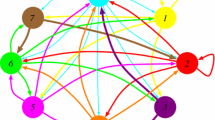Abstract
We present a theoretical basis for a novel way of studying and representing the long-time behavior of finite-dimensional maps. It is based on a finite representation of ε-pseudo orbits of a map by the sample paths of a suitable Markov chain based on a finite partition of phase space. The use of stationary states of the chain and the corresponding partition elements in approximating the attractors of maps and differential equations was demonstrated in Refs. 7 and 3 and proved for a class of stable attracting sets in Ref. 8. Here we explore the relationship between the communication classes of the Markov chain and basic sets of the Conley decomposition of a dynamical system. We give sufficient conditions for the existence of a chain transitive set and show that basic sets are isolated from each other by neighborhoods associated with closed communication classes of the chain. A partition element approximation of an isolating block is introduced that is easy to express in terms of sample paths. Finally, we show that when the map supports an SBR measure there is a unique closed communication class and the Markov chain restricted to those states is irreducible.
Similar content being viewed by others
REFERENCES
Akin, E. (1993). The General Topology of Dynamical Systems, American Mathematical Society, Providence, RI.
Bowen, R. (1975). Equilibrium States and the Theory of Axiom A Diffeomorphisms, Lecture Notes in Mathematics, Vol. 470, Springer Verlag, New York.
Dellnitz, M., and Junge, O. (1998). On the approximation of complicated dynamical behavior. SIAM J. Num. Anal. (in press).
Dellnitz, M., Hohmann, A., Junge, O., and Rumpf, M. (1997). Exploring invariant sets and invariant measures. Chaos 7(2), 221-228.
Easton, R. W. (1989). Isolating blocks and epsilon chains for maps. Physica D 39(1), 95-110.
Easton, R. W. (1993). Transport of phase space volume near isolated invariant sets. J. Dynam. Diff. Eq. 5(3), 529-536
Hsu, C. S. (1987). Cell to Cell Mapping: A Method of Global Analysis for Nonlinear Systems, Springer Verlag, New York.
Hunt, F. Y. (1998). Unique ergodicity and the approximation of attractors and their invariant measures using Ulam's method. Nonlinearity 11, 307-317.
Hunt, F. Y. (1996). Approximating the invariant measures of randomly perturbed dissipative maps. J. Math. Anal. Appl. 198, 534-551.
Hunt, F. Y., and Miller, W. M. (1992). On the approximation of invariant measures. J. Stat. Phys. 66, 535-548.
Kifer, Y. (1988). Random Perturbations of Dynamical Systems, Birkhauser, Boston.
McGehee, R. (1988). Some metric properties of attractors with applications to computer simulations of dynamical systems. Preprint.
Easton, R. W., and Meiss, J. D. (1993). Exit times and transport for symplectic twist maps. Chaos 4(2), 153-165.
Meyn, S., and Tweedie, R. (1993). Markov Chains and Stochastic Stability, Communications and Control Engineering Series, Springer Verlag London, London.
Miller, W. M. (1994). Stability and approximation of invariant measures for a class of nonexpanding transformations. Nonlin. Anal. Theory Methods Appl. 23, 1013-1025.
Miller, W. M., and Akin, E. (1999). Invariant measures for set valued dynamical systems. Trans. Am. Math. Soc. 351, 1203-1255.
Mischaikow, R., and Mrozek, M. (1998). Chaos in the Lorenz equations: A computer assisted proof. II. Details. Math. Comp. 67(223), 1023-1046.
Osipenko, G. Construction of Attractors and Filtrations, Banach Center Publications, 47, Polish Academy of Sciences, Warszawa, pp. 173-192.
Resnick, S. J. (1992). Adventures in Stochastic Processes, Birkhauser, Boston, Basel, Berlin.
Robinson, C. (1995). Dynamical Systems: Stability, Symbolic Dynamics, and Chaos, CRC Press, Boca Raton, FL.
Shub, M., Tischler, D., and Williams, R. (1988). The Newtonian graph of a complex polynomial. SIAM J. Math. Anal. 19, 246-256.
Stuart, A. M., and Humphries, A. R. (1996). Dynamical Systems and Numerical Analysis, Cambridge University Press, New York.
Conley, C. (1978). Isolated Invariant Sets and the Morse Index, CBMS 38, American Mathematical Society.
Author information
Authors and Affiliations
Rights and permissions
About this article
Cite this article
Hunt, F.Y. Finite Precision Representation of the Conley Decomposition. Journal of Dynamics and Differential Equations 13, 87–105 (2001). https://doi.org/10.1023/A:1009092431497
Issue Date:
DOI: https://doi.org/10.1023/A:1009092431497




